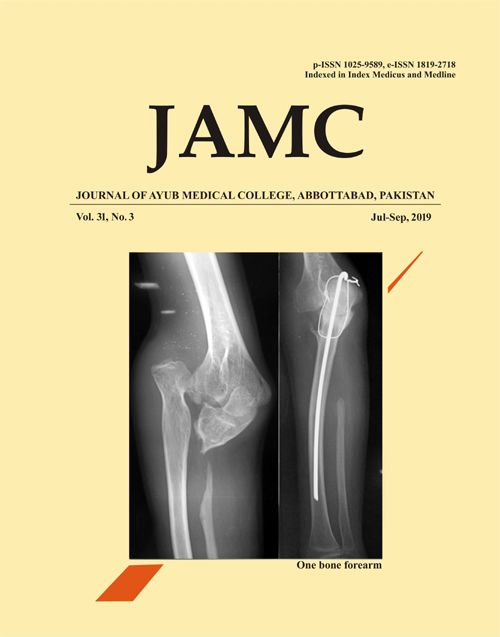EFFECT OF LIGNOCAINE ADDITION ON THE PROPERTIES OF IRREVERSIBLE HYDROCOLLOID IMPRESSION MATERIAL
Abstract
Background: Irreversible hydrocolloid impression materials have been a staple in dentistry and useful for the fabrication of dental prosthesis. Gagging is most commonly experienced during maxillary impression making, which may affect the clinical management of the patient. Different techniques have been described to alleviate this problem. One of them is mixing lignocaine local anesthetic solution in irreversible hydrocolloid impression material before making the impression.The objective of this study was to evaluate the effect of lignocaine addition in irreversible hydrocolloid impression on the properties of irreversible hydrocolloid impression materials. Methods: Irreversible hydrocolloid was mixed with water (Control group) or water and adrenalin (Lidocaine hydrochloride) (Experimental group). Compressive strength, tear strength and setting time were measured according to ISO1567 and ANSI/ADA specifications 18. The structural analysis of both groups was also evaluated by Fourier Transform Infrared Spectroscopy (FTIR). Results: In the experimental group, insignificant decrease was observed in compressive and tear strength of irreversible hydrocolloid (p >0.05). There was significant (p <0.05) increase in setting time of irreversible hydrocolloid impression material. FTIR analysis indicated no change in chemistry of irreversible hydrocolloid before and after setting. Conclusion: Addition of lignocaine in irreversible hydrocolloid impression material may result in control of gag reflex without affecting its mechanical and chemical properties.Keywords: Irreversible Hydrocolloid; lignocaine; Gag reflex; dental prosthesis; FTIRReferences
Dreesen K, Kellens A, Wevers M, Thilakarathne PJ, Willems G. The influence of mixing methods and disinfectant on the physical properties of irreversible hydrocolloid impression materials. Eur J Orthod 2012;35(3):381–7.
Culhaoglu AK, Zaimoglu A, Dogan E, Ozkir SE. The influence of different mixing methods on the dimensional stability and surface detail reproduction of two different brands of irreversible hydrocolloids. Eur J Gen Dent 2014;3(1):17.
Nandini VV, Venkatesh KV, Nair KC. Alginate impressions: A practical perspective. J Conserv Dent 2008;11(1):37–41.
ISO 1563:1990. Dental alginate impression material [Internet]. International Organization for Standardization. 1990 [cited 2018 Oct 28]. Available from: http://www.iso.org/cms/render/live/en/sites/isoorg/contents/data/standard/00/61/6157.html
Anusavice KJ, Kenneth J. Phillips’ Science of Dental Materials. 11th ed. London: Elsevier Health Sciences, 2003; p.832.
Nallamuthu NA, Braden M, Patel MP. Some aspects of the formulation of irreversible hydrocolloid dental impression materials—Setting characteristics and mechanical properties. Dent Mater 2012;28(7):756–62.
Hearing CM, Bind RH, Tabacco MJ, Hallock RM. A Reliable and Valid Survey to Predict a Patient’s Gagging intensity. J Oral Maxillofac Res 2014;5(2):e3.
Farrier S, Pretty IA, Lynch CD, Addy LD. Gagging during impression making: techniques for reduction. Dent Update 2011;38(3):171–6.
Al–Nuaimy KM. Gag Problem in Dental Treatment Assessment and Methods to Control it. Al–Rafidain Dent J 2010;10(12):287–91.
Bilello G, Fregapane A. Gag reflex control through acupuncture: a case series. Acupunct Med 2013;32(1):24–7.
Thayer M L. The use of acupuncture in dentistry. Dent Update 2007;34(4):244–50.
Hussain S, Batool S, Yazdanie N. Gag reflex: Not A dilemma any more. Biomedica 2016;32(4):277.
Haas DA. An update on local anesthetics in dentistry. J Can Dent Assoc 2002;68(9):546–52.
Karm MH, Park FD, Kang M, Kim HJ, Kang JW, Kim S, et al. Comparison of the efficacy and safety of 2% lidocaine HCl with different epinephrine concentration for local anesthesia in participants undergoing surgical extraction of impacted mandibular third molars: a multicenter, randomized, double-blind, crossover, phase IV trial. Medicine (Baltimore) 2017;96(21):e6753.
Kamran M, Qamar R. An easy and effective way to reduce gag during orthodontic impression recording. Pak Orthod J 2016;8(1):17–20.
Council on Dental Materials, Instruments, and Equipment. Addendum to American National Standards Institute / American Dental Association Specification No. 19 for Dental Elastomeric Impression Material. J Am Dent Assoc 1982;105(4):686.
Fayaz A, Noori A. Evaluation of tear strength of two types of Iralgin and comparison with similar irreversible hydrocolloid impression material. J Dent Sch 2016;34(1):28–33.
Khan SA, Khalid H, Sarfraz Z, Khan M, Iqbal J, Nawshad JI, et al. Vibrational spectroscopy of selective dental restorative materials, Appl Spect Rev 2017;52(6):507–40.
Muzaffar D, Choudhary S, Jameel RA, Afaq A, Tanwir F, Hashmi S. A Practical Guide to Use and Methods of Disinfection of Irreversible hydrocolloid Impression Materials. EC Dent Sci 2015;3(3):515–26.
Published
Issue
Section
License
Journal of Ayub Medical College, Abbottabad is an OPEN ACCESS JOURNAL which means that all content is FREELY available without charge to all users whether registered with the journal or not. The work published by J Ayub Med Coll Abbottabad is licensed and distributed under the creative commons License CC BY ND Attribution-NoDerivs. Material printed in this journal is OPEN to access, and are FREE for use in academic and research work with proper citation. J Ayub Med Coll Abbottabad accepts only original material for publication with the understanding that except for abstracts, no part of the data has been published or will be submitted for publication elsewhere before appearing in J Ayub Med Coll Abbottabad. The Editorial Board of J Ayub Med Coll Abbottabad makes every effort to ensure the accuracy and authenticity of material printed in J Ayub Med Coll Abbottabad. However, conclusions and statements expressed are views of the authors and do not reflect the opinion/policy of J Ayub Med Coll Abbottabad or the Editorial Board.
USERS are allowed to read, download, copy, distribute, print, search, or link to the full texts of the articles, or use them for any other lawful purpose, without asking prior permission from the publisher or the author. This is in accordance with the BOAI definition of open access.
AUTHORS retain the rights of free downloading/unlimited e-print of full text and sharing/disseminating the article without any restriction, by any means including twitter, scholarly collaboration networks such as ResearchGate, Academia.eu, and social media sites such as Twitter, LinkedIn, Google Scholar and any other professional or academic networking site.









